The customer is always right. Or, in the case of the Hawaiian Electric Company (HECO), the more appropriate saying might be "the small commercial customer is always ripe" - as in ripe for energy savings opportunities. That's the thinking behind HECO's small commercial direct load control pilot program. HECO had long suspected that this typically underserved market was also an untapped area for significant energy savings. So, in August 2008, the utility embarked on a five-month pilot program to test this assumption. The pilot not only served as a blueprint for how to reach the small commercial market and drive high levels of customer participation while addressing a mix of challenging factors - including the Hawaiian energy landscape - but also laid the foundation for a future large-scale program.
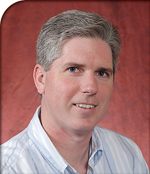
Steve Smith
Director-Sales & Marketing, Honeywell Utility Solutions
(Danvers, Mass. USA)
Peak Situation
Hawiian Electric Company has long sought ways to curb peak energy use and improve efficiency given its energy needs. The utility and its subsidiaries, Maui Electric Company, Ltd. (MECO) and Hawaii Electric Light Company, Inc. (HELCO), serve 95 percent of the state’s 1.2 million residents on the islands of O`ahu, Maui, Hawai`i Island, Lana`i and Moloka`i. Each island’s generating system operates independently of the others.
Unlike utilities on the mainland United States, HECO and its subsidiaries are not interconnected to each other or any other utilities. Additionally, they cannot tap into the national grid to buy more power when demand outpaces supply. Instead, the islands are solely responsible for generating their own power, and utilities must build additional backup capabilities into their systems. This results in higher electricity rates in Hawaii than rates on the U.S. mainland.
Further complicating Hawaii’s power reliability is the fact that year-round moderate temperatures mean air conditioners also run year-round. This creates more chances for periods of peak demand, when energy use strains the electric supply and can result in disruptive brownouts and blackouts.
These circumstances prompted HECO to establish more reliable and affordable electric service – especially during periods of peak demand and system emergencies. Among HECO’s earlier efforts was the implementation of a residential load control program, beginning in 2005.
The program involved installing remote-controlled switches on in-home electric water heaters and cooling systems. The devices enabled HECO to temporarily turn off the heaters and cycle off the cooling systems during peak demand periods and generation emergencies, when electricity demand far outpaces available supply. It also allowed HECO to obtain more control over electricity use among its residential customers, which puts the utility in a better position to supply power across the island without interruption.
When program enrollment soared and HECO reached the initial program goals, curtailing 27 megawatts as of Dec. 31, 2009, the utility turned its sights to its small commercial customer base to test a similar program.
“After the success of our residential program, we wanted to see if we could achieve the same results with small commercial customers,” said Keith Block, Program Manager. “But, would they participate? We knew the potential for savings was there, but we also knew this would be a more challenging market to reach.”
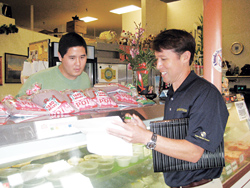
HECO representative reviewing program details
with business customer
Commercial Appeal
HECO tapped Honeywell to help implement the small commercial pilot program. The pilot targeted customers with demand levels typically ranging from 10 kilowatts to 200 kilowatts. HECO singled out these customers for the installation of load control devices on various appliances, including water heaters and air conditioners with a minimum of three tons in capacity. This excluded small commercial customers with window air conditioning units.
The program’s components were similar to those of the residential load control program and centered on the installation of a radio-controlled device near air conditioners or water heaters. Each device is enabled with an under-frequency relay. If energy demand on the island threatened to exceed the utility’s ability to supply electricity, the device would sense the emergency and shut down the power supply to the equipment in less than a second, according to Block.
Small commercial customers who enrolled in the free program would receive the device at no cost. For their participation, they’d also receive a credit on their bill each month for the duration of their involvement; thus, further helping them save money while driving the utility’s ability to provide uninterrupted power.
HECO aimed to offset 340 kilowatts of load by the end of the pilot’s five-month run – equivalent to the installation of devices on 127 water-heating units and 290 air-conditioning units, respectively. HECO based these unit goals on its own assumptions for how much load it could control given its experience with the residential load control program. The utility also tapped engineering calculations from an outside consultant and ultimately came to the conclusion that it could control 0.67 kilowatt per water heater and 0.88 kilowatt per air conditioner.
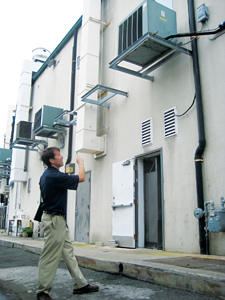
HECO sales person walking perimeter of
building to pre-qualify business
In mid-August 2008, the pilot began with the formation of a customer support team and the implementation of a management tracking system to help administer the program. HECO also developed the necessary marketing materials to help drive program interest among its customers.
Before trying to sell the program to customers, however, the program team needed to pre-qualify potential candidates. This entailed gathering information on customers’ air conditioning units and water heaters via phone or obtaining the air conditioner or water heater vendor service contracts.
Efforts also included physically observing the customer’s business – and, if possible, its individual water heaters and air conditioning units – to assess the size and ensure the customer would even qualify for the program. For this reason, HECO cites expertise and prior experience in the field as key factors to getting the program up and running.
“We had a limited amount of time to reach our goals and enroll often difficult-to-reach customers, so having a good sales and technical person in the field to quickly pinpoint controllable loads was especially useful in the process,” Block said.
For example, field personnel immediately ruled out customers they observed with high heat loads in small spaces, like small bakeries, where temperature comfort levels are critical and even slight adjustments to a customer’s heating load could wreak havoc on normal operations.
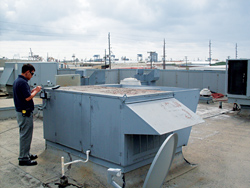
Technician on roof reviewing A/C units
Surround-Sound Recruitment
When the time did come to contact customers about enrollment, HECO took an approach slightly different from those typically taken with other customer load control programs.
“Small commercial customers are always a bit more of a challenge and require more services than other customer segments,” Block said. “You’re usually trying to get the attention of one or two people who wear many different hats within their organization, and they don’t have the dedicated time like a facility manager might to figure out everything on their own.”
Specifically, field personnel dedicated more time to speaking with the targeted customers to carefully explain the benefits of the program. HECO also put in place a dedicated team member in the field to talk with customers and help solve issues when necessary.
To capture the attention of potential participants and set the stage for these conversations, HECO used two distinct direct marketing pieces. The first piece, targeted at small business customers, simply informed them of the program, how it works and its various benefits.
For the second piece, HECO targeted 19,503 residential customers enrolled in the residential load control program. This approach was largely driven by the residential program’s high satisfaction levels and low dropout rate of less than one-tenth of 1 percent, according to Block.
The piece led with a question asking if the customers would recommend the program to friends and associates, and then probed deeper, asking if they thought their employer would be interested in the small commercial pilot. This approach ultimately resulted in 212 customers responding yes, and became a primary lead source for the pilot.
“We saw an opportunity to leverage the residential program’s success and took a more innovative, grassroots approach,” Block said. “Personal recommendations can be powerful, and we wanted to tap into that.”
Driving general awareness and spreading the message about the small commercial load control program ultimately led to customers enrolling at higher-than-expected rates. Overall, the direct mail pieces garnered more than 600 leads, and to complement these efforts, canvassing work also generated 400 leads.
Flexible Forces
HECO found the balance between minimal interruptions and the bill credit proved especially appealing to small commercial customers. Beyond the initial interest, though, were additional challenges for getting the pilot up and running that required special adjustments and flexibility.
“Our small commercial customer targets were receptive to the idea of saving money, and convincing them to sign up for the program — once we made contact with them — wasn’t that challenging,” Block said. “Closing the deal and doing our homework to ensure each customer was cut out for the program, even after they expressed interest, proved more time consuming.”
Ultimately, a bulk of the pilot program’s setup efforts came after the initial marketing and canvassing, beginning with the enrollment process. The pilot required all participants to sign a program application indicating their approval of the load control device installation. For those sites not occupied by the owner, HECO required the signatures of both the tenant and the landlord, which accounted for nearly half of the pilot’s participants. This added time on to the closure process, and the rate of closure fell behind the sales lead generation rate. As a result, HECO shifted the bulk of its attention to enrolling owner-occupied properties.
Shifts like this affected the types of customers targeted for enrollment due to both timing and available loads. For example, franchise sites added an extra layer of approval in the decision-making process and extended the sales cycle. Despite the timing issues, franchise sites offered potential high-yield installation opportunities due to the multi-unit installations typical for these locations – just the kind of installations HECO sought in order to reach its pilot goals.
HECO also approached food establishments with caution, knowing this segment would make for a less-than-ideal pilot participant due to comfort concerns, and industry health and food preparation standards. For example, when HECO cycles air conditioners off during events, the temperature can rise, altering comfort and acceptable temperature levels. Also, turning off water heaters for even a small amount of time could lower water temperatures enough to put a restaurant in violation of regulations.
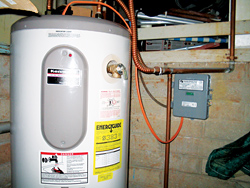
Remote-controlled switch on water heater. This
device enables HECO to temporarily turn off heaters
during peak demand periods and generation
emergencies, when electricity demand far
outpaces available supply.
Knowing the potential for issues like these, program engineers implemented manual “practice” load-shedding events at customer sites during the sign-up and installation periods. These practice tests entailed mimicking what would happen during an actual load curtailment event for two to three hours in order to determine what affect it would have on business operations and ensure no major issues would occur. This included a test event at a restaurant during the noon rush, for example.
“We wanted to ensure there would be no surprises during an actual event,” Block said. “Some customers really aren’t a fit for this type of program, and we did our homework in trying to make sure we didn’t enroll a site that would only experience adverse effects during an event.”
Measurement and verification also played a critical role in the program. During the installation process, personnel measured and verified the curtailable load and added each calculation to the cumulative total. This helped measure installations against HECO’s target and ensured it was on track to meet its goals.
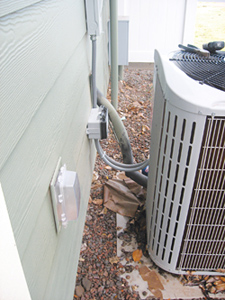
Remote-controlled switch on A/C. This
device enables HECO to also temporarily
cycle off cooling systems during peak
demand periods and generation emergencies.
Diverse Considerations
This kind of due diligence was especially important given the diversity of the customers HECO evaluated for the program. Of those who fell into HECO’s “small commercial” category, all displayed different needs and characteristics that influenced if they fit well with the pilot.
For example, industrial parks served as a consistent source of air conditioner-packaged units, typically featuring 1 to 3 packaged units per business. Also, most of these businesses do not have exposure to the public, which made them better fits for the program due to fewer comfort concerns. And, because property management companies typically oversee office parks, the sales cycle was relatively short due to one main point of contact.
HECO found that other ideal candidates included hair salons because of their water heaters, as well as doctors’ offices and other health services. Condominium common areas qualified and typically featured a high number of water heaters in one location, with significant available loads.
HECO found that other ideal candidates included hair salons because of their water heaters, as well as doctors’ offices and other health services. Condominium common areas qualified and typically featured a high number of water heaters in one location, with significant available loads.
Schools and churches were also very responsive to the program and typically qualified, while food and beverage stores were not ideal candidates due to their perishable items. Also, very small stores often did not qualify for the program since they mostly rely on either window air conditioners or wall units.
In addition to specific customer needs and characteristics, Block also emphasized that having a diversity of curtailable loads was critical for the pilot.
“We realized early on in the pilot that we needed to diversify so that if one type of load didn’t respond, we could still curtail enough load during an event to achieve our goals,” he said. “Fortunately, the benefit of working with small commercial customers is that they are so diverse.”
Proof in Results
By the end of the pilot period in December 2008, 127 customers had enrolled and personnel installed 417 switches, resulting in 755 kilowatts of curtailable load.
The actual load captured was more than double the expected load, despite the number of installed switches being equal to the original goal. HECO attributes this difference to encountering larger-than-expected airconditioning systems during installation — another result of the diverse small commercial customer base. Moving forward, HECO plans to begin a full load control program for its small commercial customers once it receives regulatory approval.
“The pilot helped show us the market is there for a full program and that the technology works with this kind of customer,” Block said. “We now have a better understanding of all the nuances specific to our small commercial customers and are confident that we can replicate this success on a broader scale for greater energy savings in the future.”
About the Author
Steve Smith is the director of sales and marketing for Honeywell Utility Solutions http://www.honeywell.com/utility, which has 25 years of experience designing and implementing demand response programs for utilities. The business has installed more than 950,000 load control devices to date, which makes it the largest implementer of residential demand response in North America. It also provides smart metering, and energy and water conservation solutions to utilities. Steve has been working with utilities for more than 17 years. He has an MBA from Northeastern University, as well as a bachelor’s degree in Electrical Engineering from the University of New Hampshire. Steve can be reached at stephen.smith7@honeywell.com.








